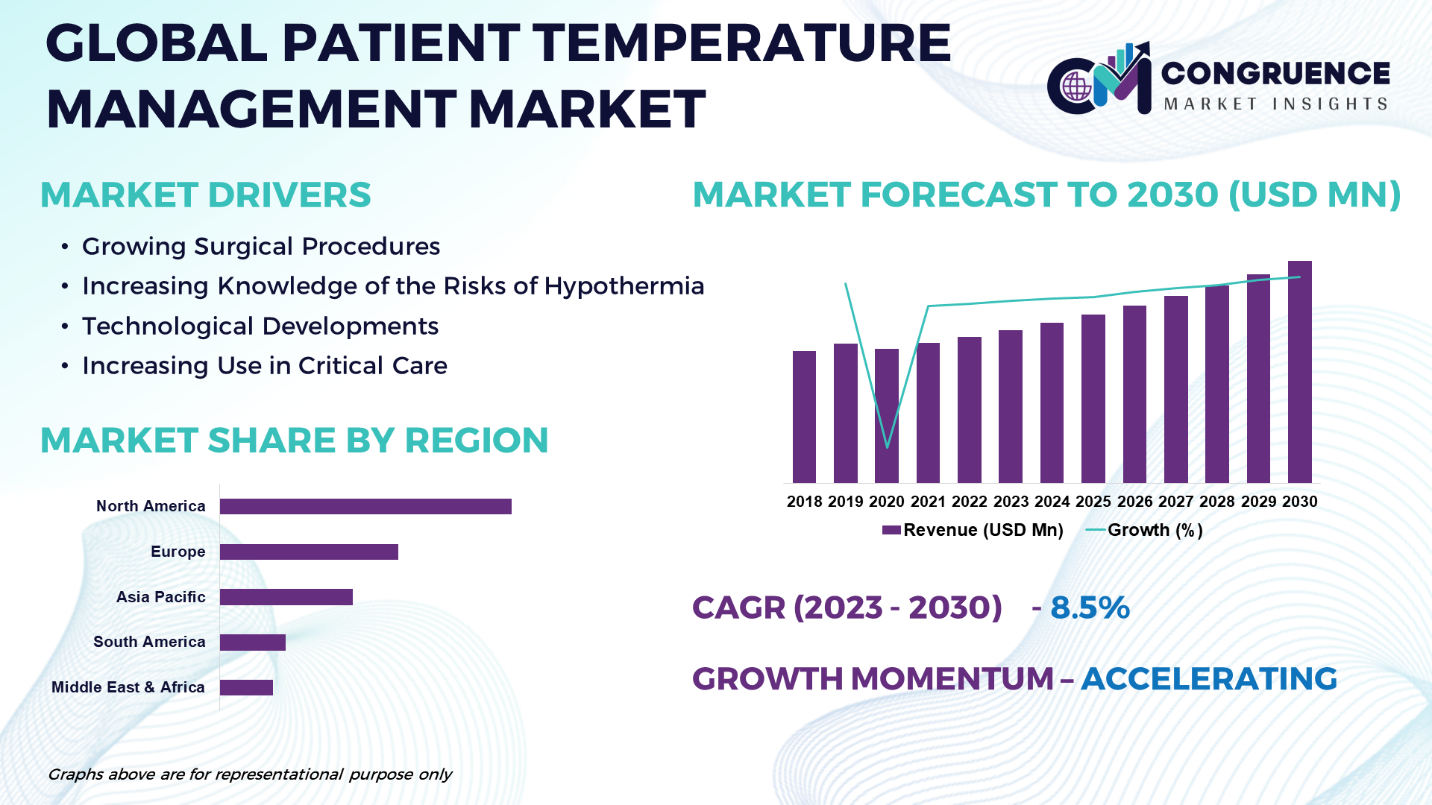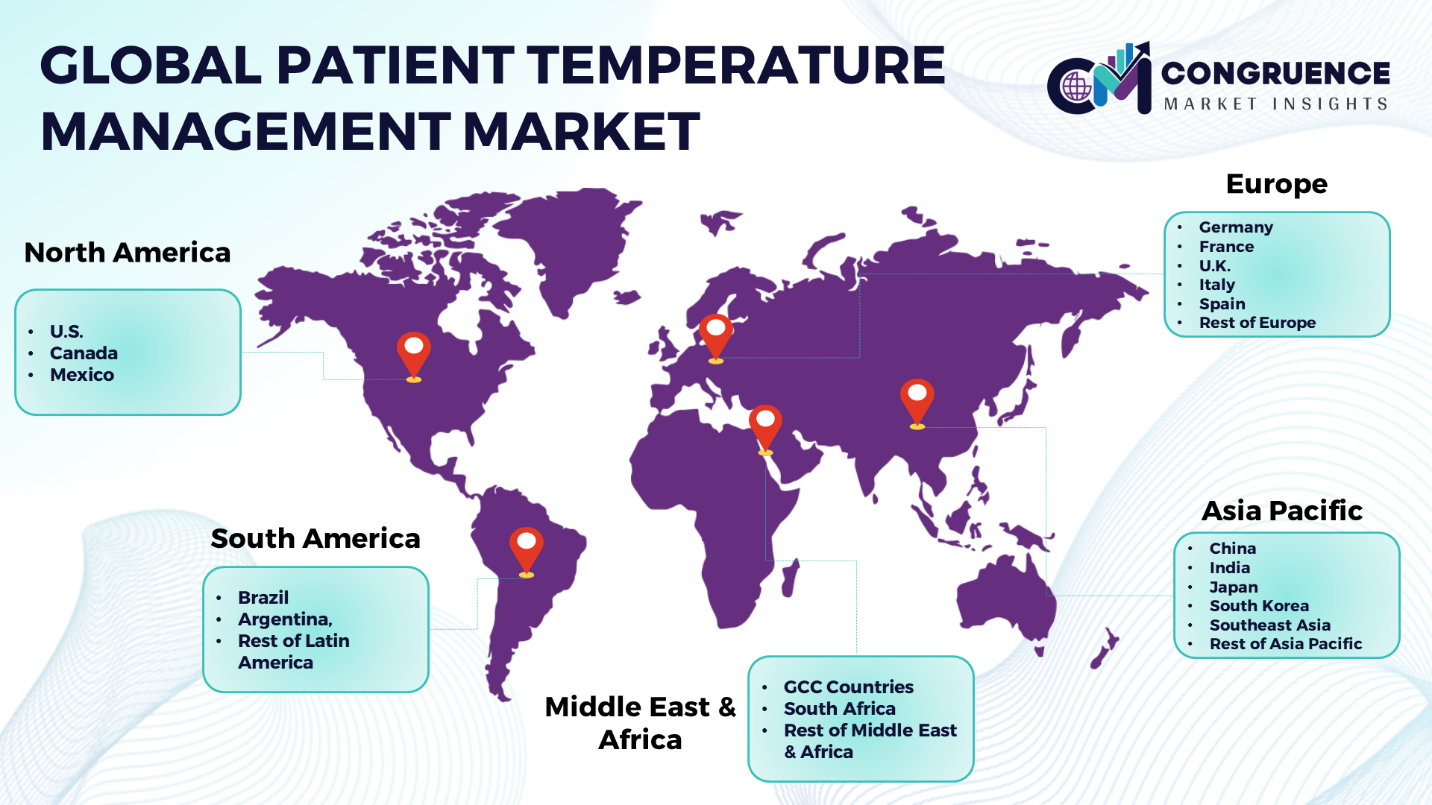Reports
The Global Patient Temperature Management Market is expected to expand at a CAGR of 8.5% between 2023 and 2030. Maintaining a patient's body temperature within a safe and ideal range during various medical procedures and situations is the fundamental goal of the worldwide patient temperature management market. Maintaining body temperature during procedures and critical care environments is essential for patient safety and healing. Not only is it important to keep patients warm, but temperature control also helps avoid hypothermia or overheating, two conditions that can cause problems during medical treatments. Hypothermia, for instance, can hinder the healing process and raise the possibility of infection, whilst hyperthermia can result in tissue damage and other issues. Surface temperature management systems, warming blankets, cooling pads, intravascular catheters, and other devices and methods are examples of patient temperature control solutions. By precisely controlling a patient's body temperature, these devices assist medical professionals in creating the ideal environment for healing and recovery. The need for temperature control systems is only going to increase as medical procedures change and patient safety stays the primary concern. These technologies are used by hospitals, ambulatory surgery centers, and emergency rooms to improve patient outcomes, reduce complications, and raise standard of care.

Patient Temperature Management Market Major Driving Forces
Growing Surgical Procedures: One major factor propelling the patient temperature management market globally is the rise in surgical procedures. In order to avoid hypo- or hyperthermia, surgical patients frequently need precise temperature control, which increases the demand for temperature management solutions in operating rooms and post-anesthesia care units.
Increasing Knowledge of the Risks of Hypothermia: Medical professionals are becoming more aware of the hazards of perioperative hypothermia, including the possibility of surgical site infections, protracted recovery periods, and unfavorable cardiovascular events. The use of temperature control tools and methods to preserve normothermia during surgery and enhance patient outcomes is fueled by this awareness.
Technological Developments: The market is growing as a result of continuous temperature control technology breakthroughs, such as the creation of novel warming and cooling systems. These developments provide more accurate temperature control, improved patient comfort, and streamlined clinical temperature management procedures for healthcare providers.
Increasing Use in Critical Care: Critical care facilities, such as intensive care units (ICUs) and emergency rooms, are using temperature management strategies in addition to surgical settings. The need for specific temperature control systems in critical care settings is driven by the vital role that temperature management plays in managing disorders including sepsis, traumatic brain injury, and cardiac arrest.
Patient Temperature Management Market Key Opportunities
Expansion into Emerging Markets: There is an increasing chance for patient temperature management solutions to fill gaps as healthcare infrastructure in these regions improves. Producers stand to gain from the growing need for temperature control equipment in areas where access to healthcare is improving and surgical volume is rising.
Creation of User-Friendly and Portable Systems: The creation of user-friendly and portable temperature management systems presents a large opportunity for innovation. Healthcare professionals can administer temperature management interventions in a variety of clinical settings, such as emergency rooms, ambulatory surgery centers, and pre-hospital care, thanks to portable and user-friendly solutions.
Integration of Smart Technologies: Improving the usability and performance of temperature control systems can be accomplished by integrating smart technologies, such as wireless communication and remote monitoring capabilities. Real-time temperature monitoring, data analysis, and predictive analytics are made possible by smart features, which give healthcare professionals the information they need to make wise decisions and improve patient care.
Patient Temperature Management Market Key Trends
· Increasing adoption of disposable temperature management products.
· Integration of smart technologies for remote monitoring and data analysis.
· Growing demand for portable and lightweight temperature management devices.
· Expansion of temperature management solutions for home healthcare settings.
· Emphasis on environmentally sustainable temperature management practices.
· Rising interest in targeted temperature management for neurological conditions.
· Adoption of closed-loop temperature control systems in critical care settings.
· Development of temperature management solutions tailored to pediatric and neonatal care.
· Integration of temperature management features into multi-functional medical devices.
· Exploration of non-invasive temperature monitoring techniques.

Market Competition Landscape
Companies compete for market share in the highly competitive patient temperature management space by providing cutting-edge solutions that are customized to meet a range of clinical needs. Prominent industry participants such as 3M Healthcare, Smiths Medical, and C.R. Bard are positioned as leaders due to their vast product portfolios and worldwide distribution networks. These businesses compete based on attributes including brand reputation, product quality, and dependability, taking advantage of their extensive global presence in healthcare institutions. Newcomers that use disruptive technologies and specialized solutions to challenge established norms include Belmont Instrument Corporation and Augustine Temperature Management. These businesses drive innovation and push the limits of patient temperature control by bringing new viewpoints to the market. They want to take market share and draw in healthcare providers by concentrating on certain markets or launching cutting-edge features. Prominent players in the market include:
· 3M Healthcare
· Smiths Medical
· C.R. Bard
· Augustine Temperature Management
· Belmont Instrument Corporation
· Stryker Corporation
· ZOLL Medical Corporation
· Enthermics Medical Systems
· Inspiration Healthcare Group plc
· GE Healthcare
· Inditherm plc
· Geratherm Medical AG
· Attune Medical
· Ecolab Inc.
· Stryker Corporation
|
Report Attribute/Metric |
Details |
|
Base Year |
2022 |
|
Forecast Period |
2023 – 2030 |
|
Historical Data |
2018 to 2022 |
|
Forecast Unit |
Value (US$ Mn) |
|
Key Report Deliverable |
Revenue Forecast, Growth Trends, Market Dynamics, Segmental Overview, Regional and Country-wise Analysis, Competition Landscape |
|
Segments Covered |
· By Product Type (Surface Warming Systems, Intravascular Warming Systems, Patient Warming Blankets, Patient Cooling Systems, Others) · By Application (Perioperative Care, Acute Care, Neonatal Care, Others) · By End-user (Hospitals, Ambulatory Surgical Centers, Specialty Clinics, Home Care Settings) |
|
Geographies Covered |
North America: U.S., Canada and Mexico Europe: Germany, France, U.K., Italy, Spain, and Rest of Europe Asia Pacific: China, India, Japan, South Korea, Southeast Asia, and Rest of Asia Pacific South America: Brazil, Argentina, and Rest of Latin America Middle East & Africa: GCC Countries, South Africa, and Rest of Middle East & Africa |
|
Key Players Analyzed |
3M Healthcare, Smiths Medical, C.R. Bard, Augustine Temperature Management, Belmont Instrument Corporation, Stryker Corporation, ZOLL Medical Corporation, Enthermics Medical Systems, Inspiration Healthcare Group plc, GE Healthcare, Inditherm plc, Geratherm Medical AG, Attune Medical, Ecolab Inc., Stryker Corporation |
|
Customization & Pricing |
Available on Request (10% Customization is Free) |
